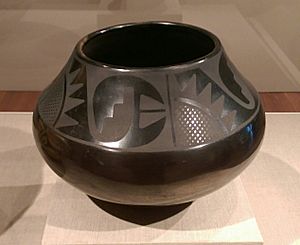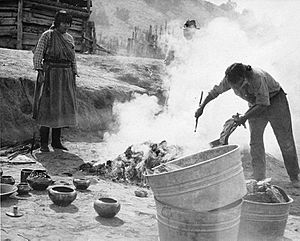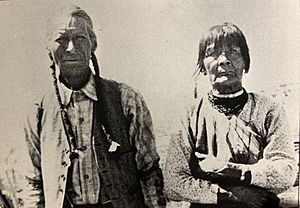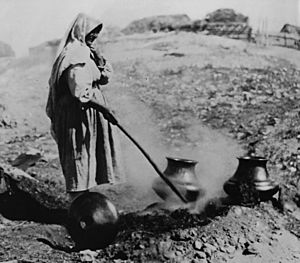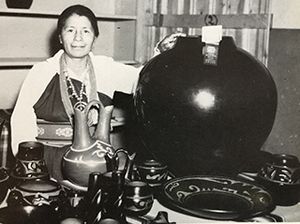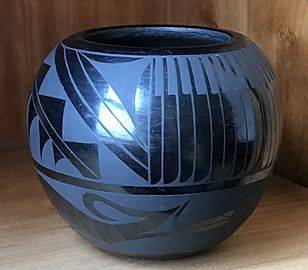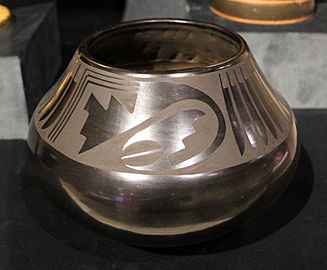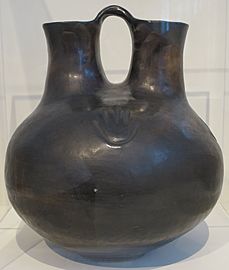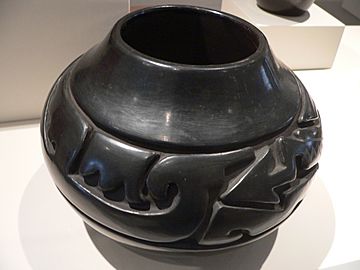Black-on-black ware facts for kids
Black-on-black ware is a special type of pottery made by Native American artists from the Pueblo communities in Northern New Mexico. While people have made black pottery for hundreds of years, the black-on-black style became popular in the 20th century. This pottery has a smooth, shiny black surface with designs that are also black but have a duller, matte finish.
Artists create these designs by carefully polishing certain areas of the pot or by adding a special clay mixture called "slip." Sometimes, they carve or scratch designs into the pot and then polish the raised parts. For many generations, families from the Santa Clara Pueblo (called Kha'po Owingeh) and the San Ildefonso Pueblo (called P'ohwhóge Owingeh) have been making this pottery. They pass down their techniques from older potters, often from mothers and grandmothers. Artists from other pueblos also create black-on-black ware, and many modern artists honor their ancestors' pottery traditions.
Contents
What is Blackware and Black-on-Black Ware?
Artists from Santa Clara Pueblo and San Ildefonso Pueblo have made traditional black pottery for a long time. They use a special clay and fire it in an outdoor pit. To make the clay black, they smother the fire with powdered animal waste, which reduces the oxygen. This process turns the clay black. Another way to blacken the clay is by "smudging." They surround the pots with metal sheets to limit oxygen, then add damp manure. The smoke makes the clay absorb carbon, giving it a black finish.
Black-on-black ware is a bit different because it has a very smooth surface. The designs are made by carefully polishing parts of the pot or by applying a special clay mixture that doesn't shine. This type of pottery uses a very fine clay. Both traditional blackware and black-on-black ware are usually made by hand-coiling local clay and firing it in a pit. You can find many beautiful black-on-black ware pots in museums and private collections today.
In the early 1900s, there was a big change from the older blackware to the new black-on-black style. This change happened thanks to the amazing work of María Martinez from San Ildefonso Pueblo.
San Ildefonso Pueblo Artists
In 1910, María Poveka Martinez and her husband Julián from San Ildefonso Pueblo created a new technique for black-on-black pottery. Their method involved making blackware with fine clay and firing it in a cow-dung fire. By 1918, they had perfected the technique. They created designs by polishing certain areas of the pot, making them shiny, while other areas remained dull. The polished parts looked like shiny silver-black. Sometimes, they painted the dull areas with a special iron-rich clay. By 1925, María Martinez's pots were very popular and sold well. The money earned helped the pueblo build new homes and buy farming tools.
María Martinez also worked with her son, Popovi Da (1921–1971), between 1956 and 1970. Popovi Da was known for trying new things and making very precise designs. He also brought back and improved old pottery techniques. He became very good at creating a shiny, dark "gunmetal-black" finish by knowing exactly when to stop the oxygen during the firing process.
Popovi Da's son, Tony Da (1940–2008), also made pottery. He used a technique called sgraffito etching, where he scratched designs into the surface. He also found a way to have both black-on-black and a reddish-brown color on the same pot. He could make his pots have a "shimmering," mirror-like gunmetal-black finish.
Santana Roybal Martinez (1909-2002) was part of María Martinez's family. She learned from María and Julián and would sometimes sign her pots "Marie and Santana." When Julián passed away in 1943, Santana took over polishing and decorating María's pots. Later, when María was too old to fire her own pots, Santana took on that job too. Santana and her husband, Adam Martinez (María and Julián's eldest son), became famous artists themselves. Their work is now in many collections.
Carmelita Vigil Dunlap (born 1925) was raised by her aunts, María Martinez and Desideria Martinez. She started making black-on-black ware in the 1950s. Her daughters, Linda Dunlap (born 1955), Jeannie Mountain Flower Dunlap (born 1953), and Cynthia Star Flower Dunlap (born 1959), also work in the burnished black-on-black style.
Rose Cata Gonzales (1900–1989) was known for her polished blackware and black-on-black pottery. She created a new style in the 1930s with deeply carved designs. She and her son Tse-Pé (born 1940) sometimes worked together. Tse-pé and his wife Jennifer have worked together for many years, from gathering clay to firing the finished pots.
Barbara Gonzales makes unique blackware with delicate lines scratched into the surface, showing a layer of red clay underneath. This creates a different kind of black-on-black look. She often adds small precious stones and coral to her pots.
Crucita Gonzalez Calabaza (Blue Corn) (1920–1999) was inspired by María Martinez, whom she watched work in the pueblo. She is known for both her colorful pottery and her black-on-black work.
Santa Clara Pueblo Artists
Five generations of potters from the Tafoya family in Santa Clara Pueblo have made carved blackware and, later, smooth black-on-black ware. A very important potter from this family was Sara Fina Tafoya (1863–1949). Both Sara Fina and her husband Geronimo made polished blackware. Sara Fina expected her children to make perfect pottery, while Geronimo focused on growing food. She was considered the best Tewa potter of her time because of the beauty, size, and variety of her work. She was especially good at making polished blackware and carved black-on-black ware.
Sara Fina's daughter, Margaret Tafoya (born 1904), and her granddaughter, LuAnn Tafoya (born 1938), also create black-on-black pottery. LuAnn learned polishing from her mother when she was twelve, before she even started making her own pots. When she began making pots, she challenged herself by creating very large pieces; her first storage pot was 23 inches tall! She learned from her family how important it is to follow traditions, use specific designs with their meanings, dig local clay, and use open-flame firing techniques.
Another daughter of Sara Fina Tafoya, Christina (Tafoya) Naranjo (1891–1980), is also known for her blackware. Her granddaughter Mary Cain (1915–2010), great-granddaughter Linda Cain (born 1949), and great-great-granddaughter Tammy Garcia (born 1969) also make pottery. Tammy Garcia says the women artists in her family taught her everything, from digging and cleaning clay to building, decorating, and firing pots. Her geometric designs are inspired by ancient Mimbres, Acoma, and Zuni pottery.
You can look at pottery, like Mimbres or the ancient Puebloan pieces and see there's a story there. Their history wasn't recorded in books – they designed it on their vessels...detailing everything from different plants and animals in the area to cultural events and local stories. – Tammy Garcia
Nathan Youngblood (born 1954), a great-grandson of Sara Fina Tafoya, makes carved black-on-black ware and other types of pottery. He was inspired by his grandmother, Margaret Tafoya. He lived with his grandparents for a while and learned about the meaning of designs from his grandfather, Alcario Tafoya. He also learned how and where to dig clay. He helped his grandmother with polishing and learned about different clays and firing techniques from her.
Nancy Youngblood (born 1955) is known for her deeply carved, ribbed pots in blackware and redware, but she also makes some black-on-black ware. Her son, Christopher Youngblood (born 1989), is a new artist who is a great-great-grandson of Sara Fina Tafoya and a great-grandson of Margaret Tafoya. He learned pottery from his mother and says she was his "best teacher" because she had very high expectations. His highly polished, precisely carved black-on-black ware often features images of birds, koi fish, and snakes. Because his process takes a lot of time, he only makes a few pieces each year.
Toni Roller (born 1935), a granddaughter of Sara Fina Tafoya, has protected the Santa Clara cultural traditions through her art. Her son, Jeff Roller, and grandsons Ryan Roller and Jordan Roller, who are all potters, have been inspired by her work. She taught them to "start from scratch and do it the old way."
Grace Medicine Flower is known for her tiny pottery. She likes to mix different clays and combine black-on-black and redware techniques on the same pot.
Autumn Borts–Medlock (born 1967) comes from a long line of women potters. She is a great-great-granddaughter of Sara Fina Tafoya. Her work continues the tradition of carved black-on-black ware. Her unique carving style is very precise and shows detailed pictures. She says her mother encouraged her to develop her own unique designs.
The Heard Museum and the Erie Art Museum created exhibitions about Margaret Tafoya and her family's pottery. These shows highlighted her unique carved black-on-black ware and other styles, showing how traditional pots became modern art. The Denver Art Museum also had an exhibition of over 100 pottery pieces by six generations of the Tafoya family. In 1984, Margaret Tafoya was recognized as a National Heritage Fellow for her contributions to traditional arts.
Many members of the Chavarria family, starting with potter Pablita Chavarria (born 1914), are known for their black-on-black ware. These include Florence Browning (born 1931) and Stella Chavarria (born 1939).
Members of the Gutierrez family from Santa Clara Pueblo, starting with potter Leocadia Gutierrez, are also known for their black-on-black ware. Angela Tafoya Baca (1927–2014) made carved blackware pottery.
Linda and Merton Sisneros are also known for their black-on-black ware.
Artists from Other Pueblos
In the 1920s, the black-on-black style from San Ildefonso Pueblo became very popular because of María and Julián Martinez. Other artists were also inspired by Nampeyo (1959–1942), a Hopi-Tewa potter. Even though her work looked different, her deep knowledge influenced the artists at San Ildefonso Pueblo.
Helen Naha (Feather Woman, 1922–1993), a Hopi–Tewa potter, also made black-on-black ware.
Artists from Kewa Pueblo, Ohkay Owingeh, and Picuris Pueblo also make black-on-black ware, but in smaller amounts, as they mostly focus on other pottery styles.
Harrison Begay Jr. (born 1961), a Navajo artist who is also part Hopi, Jemez, and Zuni, learned black-on-black techniques from his wife and her family from Santa Clara Pueblo. His pots have traditional polished and matte black surfaces, and they are deeply carved, sometimes showing hints of the red clay underneath.
Images for kids
See also
- Pueblo pottery
- Ceramics of indigenous peoples of the Americas
- Pit fired pottery
- Pottery of the American Southwest
- Visual arts by indigenous peoples of the Americas
- List of Native American Ceramic Artists
- Black-burnished ware


